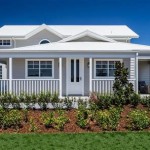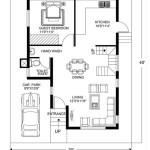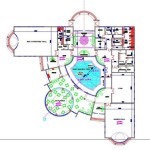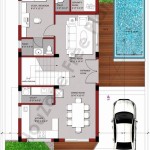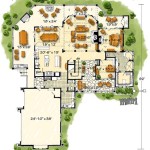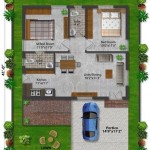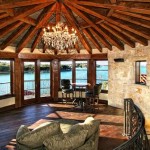4 Bedroom 2 Bath 1 Story House Plans: A Comprehensive Guide
The demand for 4 bedroom 2 bath 1 story house plans remains consistently high due to their practicality and adaptability to various family needs. Single-story homes offer ease of movement, enhanced accessibility, and a cohesive living experience, making them a desirable choice for families of all ages and stages of life. A 4 bedroom 2 bath layout strikes a balance between space efficiency and comfortable living, providing ample room without the complexities of multiple floors. This comprehensive guide explores the various aspects of planning and designing such homes, covering considerations for layout, architectural styles, cost factors, and accessibility features.
Designing a 4 bedroom 2 bath 1 story house requires careful consideration of spatial arrangement, ensuring each room is adequately sized and strategically positioned for optimal functionality. The floor plan should facilitate a smooth flow between living areas, bedrooms, and bathrooms, minimizing wasted space and maximizing the use of available square footage. Furthermore, incorporating natural light and ventilation is crucial for creating a healthy and comfortable living environment. Attention to detail in the initial planning phase can significantly impact the overall livability and value of the home.
Key Considerations for Layout and Design
The layout of a 4 bedroom 2 bath 1 story house plan is paramount to its success. It dictates how effectively the space is utilized and the comfort level experienced by the occupants. Several key considerations must be addressed during the initial design phase:
Zoning: Effective zoning separates the house into distinct areas based on function. This typically includes a public zone (living room, dining area, kitchen), a private zone (bedrooms, bathrooms), and a service zone (laundry room, garage). Proper zoning minimizes noise disruption between different activities and promotes a sense of privacy within the home.
The public zone is often located at the front of the house, creating a welcoming and accessible space for entertaining guests and family gatherings. Open-concept designs are popular choices for the public zone, as they promote interaction and create a sense of spaciousness. However, it's essential to define distinct areas within the open space through strategic furniture placement, changes in flooring, or the use of architectural elements such as columns or partial walls.
The private zone, containing the bedrooms and bathrooms, is generally located at the rear of the house or along a quieter side. This separation ensures a peaceful and restful environment for sleeping and personal activities. The master bedroom is often situated at one end of the private zone, providing enhanced privacy and potentially including features like a walk-in closet and an en-suite bathroom. The other bedrooms can be arranged to share the second bathroom, with consideration given to each room's size and proximity to the bathroom.
The service zone incorporates areas such as the laundry room, mudroom, and garage. These spaces are typically located near the entrance or kitchen for convenience. The laundry room should be adequately sized to accommodate a washer, dryer, folding table, and storage for laundry supplies. A mudroom provides a designated space for removing shoes and outerwear, preventing dirt and clutter from entering the main living areas. Integrating the garage directly into the house plan can offer easy access to vehicles and additional storage space.
Traffic Flow: A well-designed floor plan ensures smooth and efficient traffic flow between different areas of the house. Avoid creating bottlenecks or narrow hallways that can hinder movement. The main pathways should be wide enough to accommodate multiple people passing simultaneously. Consider the typical routes people will take throughout the day and ensure these paths are direct and unobstructed.
For instance, the path from the bedrooms to the kitchen should be relatively short and direct, especially for those who frequently visit the kitchen early in the morning or late at night. Similarly, the path from the living room to the bathrooms should be easily accessible for guests. It's also crucial to consider the placement of furniture and fixtures to avoid creating obstacles along these pathways. Strategic placement of rugs, plants, and other decorative elements can help define traffic flow and direct movement within the house.
Size and Proportion: The size of each room should be proportionate to its function and the overall size of the house. A master bedroom should be larger than the other bedrooms, and the living room should be spacious enough to accommodate a comfortable seating arrangement and entertainment center. The kitchen should have adequate counter space and storage to facilitate efficient food preparation and cooking.
When determining the size of each room, consider the furniture and appliances that will be placed in it. Measure the dimensions of existing furniture or research the dimensions of new furniture before finalizing the room sizes. Also, consider the amount of space needed for movement around furniture and fixtures. For example, allow at least 3 feet of clearance around a bed or dining table to ensure comfortable movement.
Natural Light and Ventilation: Maximize natural light and ventilation throughout the house by incorporating large windows, skylights, and strategically placed doors. Natural light not only brightens the interior spaces but also reduces the reliance on artificial lighting, saving energy and improving the overall ambiance. Proper ventilation ensures fresh air circulation, preventing the buildup of stale air and reducing the risk of mold and mildew.
Orient the house to take advantage of sunlight exposure. In colder climates, orienting the main living areas towards the south can maximize solar gain, reducing heating costs. In warmer climates, orienting the house to minimize direct sunlight exposure can help keep the interior cool. Consider incorporating overhangs or awnings to shade windows during the hottest part of the day. Also, consider the placement of trees and landscaping to provide natural shade and windbreaks.
Storage: Adequate storage is essential for maintaining a clutter-free and organized home. Incorporate ample closet space in each bedroom, as well as strategically placed storage cabinets in the kitchen, bathrooms, and laundry room. Consider adding a pantry in the kitchen for storing food and cooking supplies. Also, explore options for adding built-in shelving, drawers, and cabinets in other areas of the house to maximize storage capacity.
Optimize storage efficiency by using vertical space. Install shelving units that reach the ceiling, and utilize storage containers to organize items within closets and cabinets. Consider adding pull-out shelves or drawers to make it easier to access items stored at the back of cabinets. Also, explore options for adding hidden storage compartments, such as under-bed storage or storage benches.
Architectural Styles and Their Impact
The architectural style of a 4 bedroom 2 bath 1 story house can significantly influence its curb appeal, functionality, and overall aesthetic. Choosing a style that complements the surrounding environment and reflects personal preferences is crucial. Here are a few popular architectural styles and their key characteristics:
Ranch: Ranch-style homes are characterized by their single-story design, low-pitched roof, and horizontal layout. They often feature large windows, attached garages, and sprawling floor plans. Ranch homes are known for their simplicity and ease of maintenance, making them a popular choice for families and retirees.
Craftsman: Craftsman-style homes emphasize handcrafted details, natural materials, and a cozy, inviting atmosphere. They typically feature gabled roofs, wide eaves, exposed rafters, and front porches with tapered columns. Craftsman homes often incorporate wood siding, stone accents, and leaded glass windows.
Mid-Century Modern: Mid-century modern homes are characterized by their clean lines, minimalist design, and use of natural light. They often feature flat or low-pitched roofs, large windows, open floor plans, and integration with the surrounding landscape. Mid-century modern homes frequently incorporate materials such as wood, glass, and steel.
Contemporary: Contemporary-style homes embrace modern design principles, emphasizing simplicity, functionality, and energy efficiency. They often feature asymmetrical designs, clean lines, large windows, and open floor plans. Contemporary homes may incorporate a variety of materials, including wood, glass, steel, and concrete.
Farmhouse: Farmhouse-style homes evoke a sense of rustic charm and comfort. They typically feature gabled roofs, large porches, wood siding, and simple, functional designs. Farmhouse homes often incorporate reclaimed materials, such as barn wood and vintage fixtures.
The choice of architectural style should also consider the regional climate and building codes. Certain styles may be better suited for specific climates due to their energy efficiency and resistance to weather conditions. It's also important to ensure that the chosen style complies with local building codes and zoning regulations.
Accessibility and Universal Design Principles
When designing a 4 bedroom 2 bath 1 story house, it's crucial to incorporate accessibility features that cater to individuals with mobility limitations. Universal design principles aim to create homes that are usable by people of all ages and abilities. Incorporating these principles not only enhances the quality of life for individuals with disabilities but also increases the value and marketability of the home.
Ramps and Wider Doorways: Eliminate steps at entrances and replace them with ramps that have a gentle slope. Ensure doorways are at least 36 inches wide to accommodate wheelchairs and walkers. Wider doorways also make it easier to move furniture and appliances in and out of the house.
Roll-In Showers and Grab Bars: Design bathrooms with roll-in showers that have a level entrance and no threshold. Install grab bars in the shower and toilet area to provide support and stability. Consider adjustable-height showerheads and handheld sprayers for added convenience.
Lever Handles and Rocker Switches: Replace traditional doorknobs with lever handles and toggle switches with rocker switches. These features are easier to operate for individuals with limited hand strength or dexterity. Also, ensure that controls are placed at accessible heights.
Accessible Kitchen Design: Design the kitchen with adjustable-height countertops and roll-under sinks. Install pull-out shelves and drawers in cabinets to improve accessibility. Consider appliances with front-mounted controls and easy-to-read displays.
Open Floor Plans: Open floor plans provide ample space for maneuvering wheelchairs and walkers. Avoid narrow hallways and tight corners that can restrict movement. Ensure that there is sufficient turning space in all rooms.
By incorporating these accessibility features, a 4 bedroom 2 bath 1 story house can be designed to be inclusive and welcoming for people of all abilities. This not only enhances the quality of life for the occupants but also sets a positive example for future home designs.

House Plan 45467 Ranch Style With 1680 Sq Ft 4 Bed 2 Bath

Traditional Style House Plan 4 Beds 2 Baths 1701 Sq Ft 42 351 Beach Floor Plans Bedroom Flooring

House Plan 64523 One Story Style With 2354 Sq Ft 4 Bed 2 Bath

House Plan 048 00229 Ranch 1 235 Square Feet 4 Bedrooms 2 Bathrooms Small Bedroom Remodel Cottage Plans Floor

Single Story 4 Bedroom Traditional House With Bonus And Flex Room Plan

4 Bedroom Coastal Contemporary House Plan With Two Master Suites 33193zr Architectural Designs Plans

Ranch Style House Plan 4 Beds 2 Baths 1040 Sq Ft 116 257 Bedroom Plans

4 Bedrm 2399 Sq Ft European House Plan With 142 1160

One Story Four Bedroom House Plans 4 3 5 Bathroom 1 Dining Room Exerci

House Plan 45275 Ranch Style With 1198 Sq Ft 4 Bed 2 Bath

